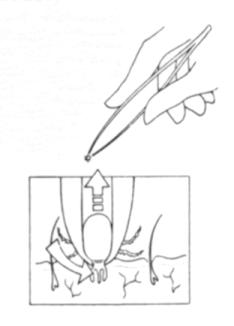An Emerging Public Health Concern
Hunterdon County Health Department (New
Jersey)
From a pamphlet produced by the
Hunterdon County Health Department (New Jersey)
(Please note that the information may have changed
since this article was written)
LYME DISEASE ... its cause and carrier
Lyme Disease is an infection caused by a spirochete, a type of bacteria. The disease is carried by certain species of ticks and transmitted to animals and humans by tick bites. In New Jersey, the deer tick is primarily responsible for the spread of Lyme disease.
LEARN TO RECOGNIZE THE EARLY SYMPTOMS
Lyme Disease is often called a "great imitator" because of its ability to mimic a wide variety of other illnesses. After a tick bite, usually 3 to 32 days later, many patients develop flu-like symptoms such as fever, headache, fatigue, muscle aches, stiff neck or vomiting.
About 50% of patients also develop a rash, either at the site of the tick bite or elsewhere on the body. The circular or oblong rash may increase in size and have well-defined margins with central clearing, giving it a characteristic "target" or "bull's eye" appearance.
SERIOUS COMPLICATIONS CAN ARISE IF LEFT
UNTREATED
These early symptoms usually disappear only to have more serious problems develop later. Untreated complications can include chronic arthritis, heart problems, and nervous system disorders. The Lyme spirochete has been implicated in birth defects, miscarriages and delayed development in children.
TREATMENT IS BASED ON DEGREE OF INFECTION
Treatment varies depending on when the diagnosis is made. Oral antibiotics for very early infections may be sufficient. Long-term infections respond best to intravenous antibiotics. Chronic cases may require extended antibiotic treatment.
Lyme disease is not difficult to treat, but is difficult to diagnose because of the variety of symptoms and the delay between the tick bite and the onset of illness. It is
important to alert your doctor if you have a tick bite and develop any of the symptoms of
Lyme disease.
TICKS MUST BE REMOVED PROPERLY
24 hours of tick attachment may be required for spirochete transmission. This makes frequent self-examination and proper tick removal an effective way to prevent infection.
 |
Using tweezers or forceps, grasp the tick as close to the skin as possible and pull with steady backward pressure. Be patient. The tick will let go. Thoroughly clean the site and remove all mouthparts. Save the tick in a jar so that it can be identified should you develop any symptoms.
- NEVER try to remove a tick by burning it or smothering it.
- These methods may injure skin and often leave the tick head embedded.
- Crushing a tick could potentially induce infection.
- Use the tweezers.
|
TICK TRIVIA
Ticks go through 3 active life stages - larva, nymph and adult. In the larva and nymph stage, ticks must find a host and take a blood meal to molt to the next stage. Male adults attach, but do not feed, while female adults need blood to produce eggs.
Female Deer Ticks are only about 1/4 inch in length and are black and brick red in color. Males are smaller and all black.
Actual DEER TICK sizes shown below:
Left to right:
larva, nymph, female adult, male adult

Ticks are not born with the spirochete responsible for Lyme disease. Larvae pick it up from infected rodents - most often the white-footed mouse, and are then capable of transmitting the disease after molting and feeding as nymphs.
Ticks are found in wooded areas, suburban back yards and high grasses. Ticks don't fly, jump or spring from trees. They are found in leafy brush waiting for an animal or person to pass by.
Tick nymphs most commonly transmit Lyme disease to humans when they feed in late May to August, although Lyme Disease is reported year round.
Ticks take time to attach and feed. In general, a tick must be attached at least 24 hours to transmit the spirochete that causes Lyme disease.
TAKE
STEPS TO PROTECT YOURSELF AND PETS
Make
life difficult for hungry ticks by tucking trousers into long socks and a
long-sleeved shirt into your pants. Wear
light colors and tightly woven fabrics. Check clothes for climbing ticks. Wear closed shoes.
Repellents
containing DEET or Permethrin have been shown to reduce exposure to ticks.
Carefully follow labeling directions.
Excessively high concentrations and repeated applications should be
avoided, especially in children.
Closely inspect all
individuals and pets returning from wooded areas.
If you find a tick, remove it properly, using tweezers or forceps.
Fit
your dogs or cats with tick collars and inspect them often, Pets can bring ticks
into the house. Keep pets off
furniture and don't let them sleep with you.
If
you are bitten, remove the tick and save it in a jar. Watch yourself for any signs of early Lyme disease and call
your physician if any develop.
Teach
your children to stay on paths and avoid tick-infested areas.
Show them what the deer tick looks like and how to safely remove ticks.
Research
has shown that careful use of insecticides, when properly formulated and timed,
can be effective in controlling various stages of the deer tick.
Granular insecticides containing carbaryl (Sevin) and labeled for tick
control, when applied in late May / early June, provide superior control of
immature ticks. Liquid
insecticides, when applied in November and March, have been shown to provide
good control of adult deer ticks. Users
should be sure to read and follow all precautions and directions on the label.
Additional information is available thru the County Cooperative Extension
service.
LYME DISEASE ...
-
KNOW
THE FACTS about the disease and the ticks that spread it.
-
TAKE
PROPER PRECAUTIONS before, during and after being in tick-infested areas.
-
SEEK
PROMPT TREATMENT if you develop symptoms.
|